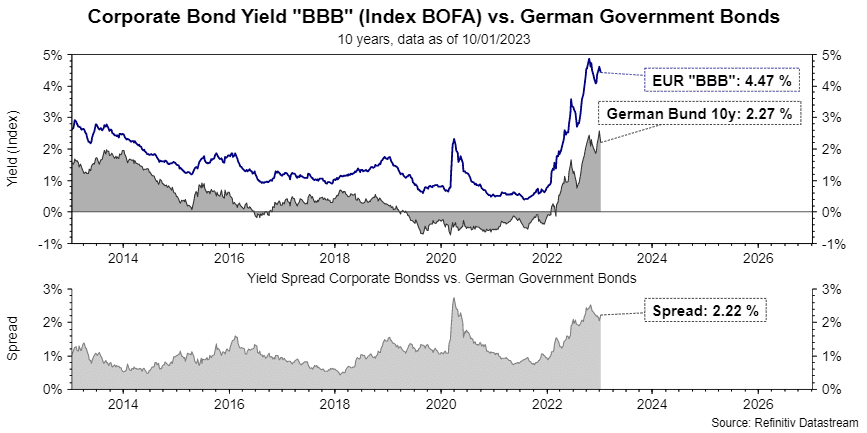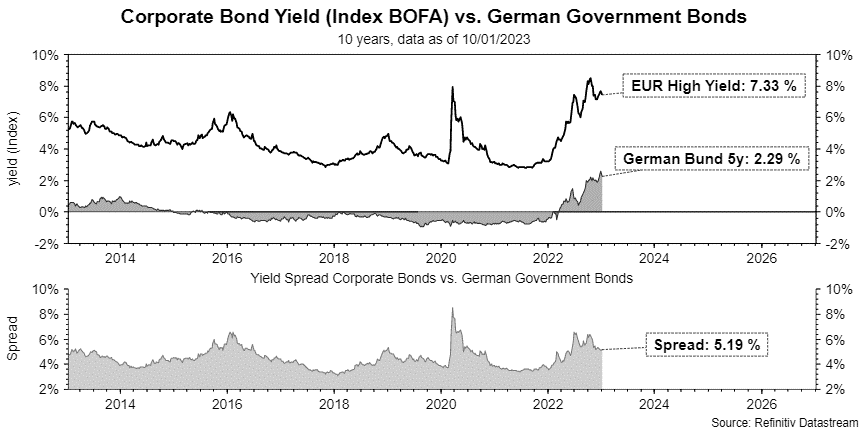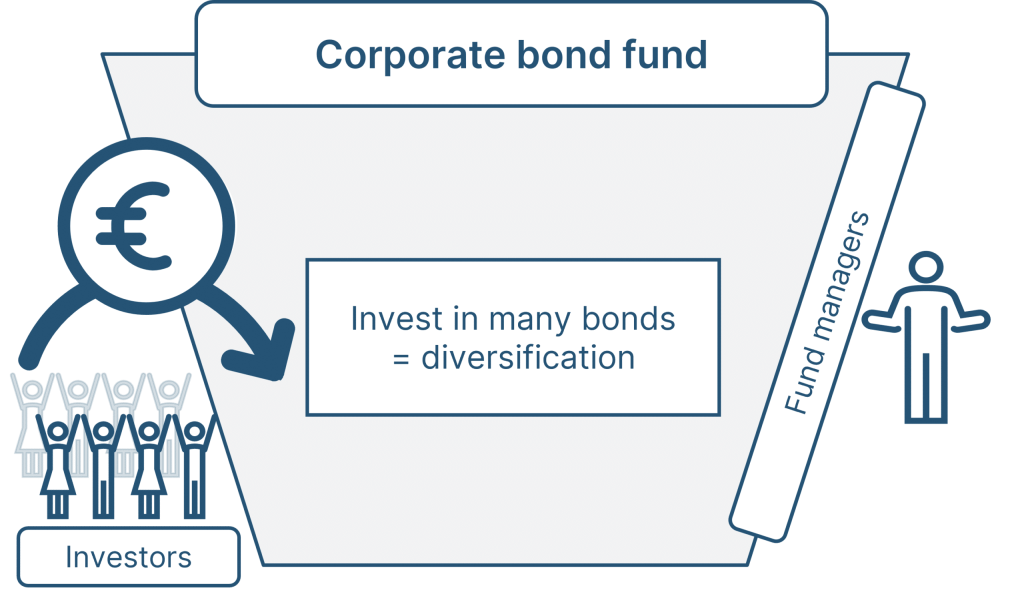When a company needs capital, it can source it from its bank as a loan, or it can issue a bond and thus raise capital from investors on the capital market. The upside of corporate bonds, from the investors’ perspective, is the fact that they usually pay a high interest rate (coupon) than government bonds of comparable maturity.
But investors who want a higher interest rate usually also have to take higher risks. With every company there is always the risk of default – and it is precisely this risk that the interest rate premium over government bonds, also called spread, is supposed to cover.
Instead of looking for individual corporate bonds, one can simply invest in corporate bond funds. Therefore, we would like to look at the following aspects in this article:
- What does a corporate bond fund do?
- Investment grade or high yield – it all depends on the rating!
- What should the investor bear in mind when investing in corporate bond funds?
Corporate bonds – a short overview
A corporate bond fund is launched and managed by an investment company. The fund usually does not have a set maturity but is designed for the long term. Investors can therefore invest in such a fund at any time.
The most important key points of a corporate bond fund are:
- Bundling of capital from many investors
- Allocation of the paid-in capital across many different bonds (issuers, countries, sectors, maturities) in order to spread the risk
- Experts (fund managers) select the bonds for the respective fund and take care of (i.e. manage) the portfolio (e.g. reinvestment when a bond has been redeemed)
Several aspects make a corporate bond fund interesting to investors:
- Investment already possible with small amounts
- Capital accumulation possible through a fund savings plan (monthly payments)
- Risk diversification, as the fund invests in bonds from different issuers
That being said, investors should always bear in mind the potential risks of such an investment:
- Issuers could get into trouble
- Bond funds tend not to come with a capital guarantee
- Capital loss is also possible for longer holding periods
Investment grade or high yield – it all depends on the rating
A corporate bond represents a loan granted to a company. And as with any loan, the borrower (in the case of corporate bonds, the issuer of the bond) must repay the principal at the end of the term and make the promised interest payments during the term.
It thus depends on the creditworthiness of the issuer whether all obligations can be met in full and on time. The creditworthiness, or in this case, rating, is usually assessed by independent rating agencies. A rough distinction is made between the following rating segments:
- Investment grade (very good to medium rating)
- High-yield (high-yield bonds, low rating)
For investors, this means that prior to an investment in a corporate bond fund, one’s own risk preference should be defined. One should not only look at the coupon of the bond or the yield of the bond fund. Because higher interest rates usually mean a higher risk for the capital invested and for the possible interest payments (default risk).
Investment grade – attractive or not?
Investment grade includes all credit rating segments from very good to medium. The probability of default is rather low. To assess the attractiveness of this asset segment, it is worth taking a look at:
- The yield of the security (in nominal terms)
- The spread in comparison with a credit-safe government bond (with comparable maturity)
The following chart illustrates these two aspects:

Below: yield differential corporate bonds vs. German government bonds
Source: Refinitiv Datastream, 10Y, data as of 10 January 2023
Note: Past performance is not reliable indicator of future performance.
The chart shows data of the index of a selected rating sub-segment from the investment grade segment in the Eurozone. Bonds from this segment are very popular among corporate bond funds. The time series goes back ten years. Two important conclusions can be drawn:
- The entry yield is currently at a higher level than in the past ten years.
- The yield differential to a German government bond (as a reference for the best possible credit rating in the Eurozone) is above 2%. The only time this spread was higher than this was in 2020 in the course of the Corona crisis.
After the rapid rise in yields in 2022, investment grade corporate bonds are currently offering entry yields above the level of the past ten years.
High-yield – maybe even more interesting?
The following chart shows the above comparison for the high-yield segment of European corporate bonds. Two remarks are in order at the outset:
- In the high yield segment, the default rate tends to be significantly higher than in the investment grade segment. This risk must be compensated by an accordingly higher yield
- Since the average maturity of bonds in the high yield segment tends to be 5Y (and thus shorter than in the investment grade segment), we also compare their yield to that of a 5Y German government bond

Below: yield differential corporate bonds vs. German government bonds
Source: Refinitiv Datastream, 10Y, data as of 10 January 2023
Note: Past performance is not reliable indicator of future performance.
At first glance, we can see:
- At currently 7.3%, the yield in the high-yield segment is significantly higher than that in the investment grade segment
- The current yield is roughly at the level we experienced during the Corona sell-off
- The spread on German government bonds is over 5%. It has only been twice in this range or slightly higher the past ten years
If you look at the current historically high inflation rates in the Eurozone as a benchmark, it seems there is a chance that by investing in the high-yield segment one could achieve a return that could roughly compensate for inflation. And at the current level, this asset represents an investment opportunity that excels as alternative to the stock market, which has not been the case for many years.
What should the investor bear in mind when investing in corporate bond funds?
As with any investment, there are also corresponding risks in addition to possible return opportunities when investing in a corporate bond fund. There is a plethora of funds in this market segment. Investors should not be tempted to invest solely on the basis of return. Among other things, the following aspects should also be taken into account:
- In what credit rating segment does the selected fund invest?
- What is the economic environment like? Can we expect higher default rates (e.g. in the event of a recession)?
- How attractive is the selected market compared to other investment alternatives?
A corporate bond fund usually offers to categories of fund shares:
- A-shares (with regular, usually annual dividends) and
- T-shares (no dividends; long-term building of capital via automatic re-investment of the return)
This means that when selecting a fund, you can decide whether you want regular income in the form of dividends or not.
Conclusion
Corporate bond yields in both the investment grade and high-yield segments have risen significantly in recent months. This means that we are now at interesting entry levels again.
Investors are spoilt for choice: there are many corporate bond funds with different investment strategies and corresponding risks. Before investing, interested investors should therefore find out exactly whether the respective fund is suitable for their investment needs.
And one final piece of advice: the more aggressive (i.e. risky) the investment, the more important it is to pursue a strategy of broad diversification.
For a glossary of technical terms, please visit this link: Fund Glossary | Erste Asset Management
Legal note:
Prognoses are no reliable indicator for future performance.
Please note that an investment in securities also entails risks in addition to the opportunities described.
Legal disclaimer
This document is an advertisement. Unless indicated otherwise, source: Erste Asset Management GmbH. The language of communication of the sales offices is German and the languages of communication of the Management Company also include English.
The prospectus for UCITS funds (including any amendments) is prepared and published in accordance with the provisions of the InvFG 2011 as amended. Information for Investors pursuant to § 21 AIFMG is prepared for the alternative investment funds (AIF) administered by Erste Asset Management GmbH pursuant to the provisions of the AIFMG in conjunction with the InvFG 2011.
The currently valid versions of the prospectus, the Information for Investors pursuant to § 21 AIFMG, and the key information document can be found on the website www.erste-am.com under “Mandatory publications” and can be obtained free of charge by interested investors at the offices of the Management Company and at the offices of the depositary bank. The exact date of the most recent publication of the prospectus, the languages in which the fund prospectus or the Information for Investors pursuant to Art 21 AIFMG and the key information document are available, and any other locations where the documents can be obtained are indicated on the website www.erste-am.com. A summary of the investor rights is available in German and English on the website www.erste-am.com/investor-rights and can also be obtained from the Management Company.
The Management Company can decide to suspend the provisions it has taken for the sale of unit certificates in other countries in accordance with the regulatory requirements.
Note: You are about to purchase a product that may be difficult to understand. We recommend that you read the indicated fund documents before making an investment decision. In addition to the locations listed above, you can obtain these documents free of charge at the offices of the referring Sparkassen bank and the offices of Erste Bank der oesterreichischen Sparkassen AG. You can also access these documents electronically at www.erste-am.com.
Our analyses and conclusions are general in nature and do not take into account the individual characteristics of our investors in terms of earnings, taxation, experience and knowledge, investment objective, financial position, capacity for loss, and risk tolerance. Past performance is not a reliable indicator of the future performance of a fund.
Please note: Investments in securities entail risks in addition to the opportunities presented here. The value of units and their earnings can rise and fall. Changes in exchange rates can also have a positive or negative effect on the value of an investment. For this reason, you may receive less than your originally invested amount when you redeem your units. Persons who are interested in purchasing units in investment funds are advised to read the current fund prospectus(es) and the Information for Investors pursuant to § 21 AIFMG, especially the risk notices they contain, before making an investment decision. If the fund currency is different than the investor’s home currency, changes in the relevant exchange rate can positively or negatively influence the value of the investment and the amount of the costs associated with the fund in the home currency.
We are not permitted to directly or indirectly offer, sell, transfer, or deliver this financial product to natural or legal persons whose place of residence or domicile is located in a country where this is legally prohibited. In this case, we may not provide any product information, either.
Please consult the corresponding information in the fund prospectus and the Information for Investors pursuant to § 21 AIFMG for restrictions on the sale of the fund to American or Russian citizens.
It is expressly noted that this communication does not provide any investment recommendations, but only expresses our current market assessment. Thus, this communication is not a substitute for investment advice.
This document does not represent a sales activity of the Management Company and therefore may not be construed as an offer for the purchase or sale of financial or investment instruments.
Erste Asset Management GmbH is affiliated with the Erste Bank and austrian Sparkassen banks.
Please also read the “Information about us and our securities services” published by your bank.




